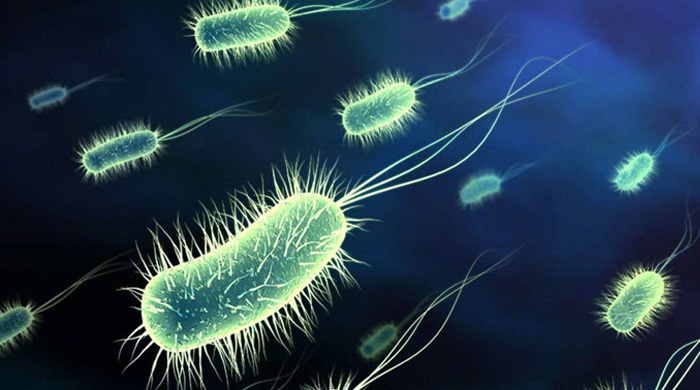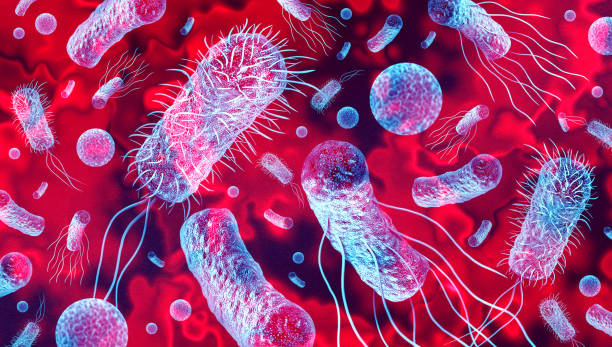Salmonella (Salmonella) is a genus of gram-negative bacteria that are among the most common pathogens of food poisoning and severe infections in humans and animals. They can cause diseases of varying severity, from mild gastrointestinal infection to severe systemic blood poisoning (sepsis).
These bacteria are transmitted through contaminated food, water, or contact with sick animals. There are known cases of mass epidemics associated with salmonellosis, which makes the fight against them an important problem for medicine, the food industry and sanitary services.
In this article, we will look at the structure and life cycle Salmonella, its pathogenicity, ways of infection, symptoms of infection, methods of diagnosis, treatment and prevention.

1. General characteristics and scientific classification
🔬 Scientific classification:
✔ The Kingdom: Bacteria (Bacteria)
✔ Type: Proteobacteria (Proteobacteria)
✔ Class: Gamma-proteobacteria (Gammaproteobacteria)
✔ Orders of magnitude: Enterobacteria (Enterobacterales)
✔ Family: Enterobacteria (Enterobacteriaceae)
✔ Gender: Salmonella
2. morphology and biological features
🔹 Main Features:
✔ Gram-negative rod-shaped bacterium
✔ Dimensions: 2-5 microns long and 0.5 microns wide
✔ Mobile (thanks to flagella)
✔ Facultative anaerobe (can survive both in the presence of oxygen and without it)
✔ Grows well in nutrient media, forming colonies
🔹 Physiological properties:
✔ Able to survive in the acidic environment of the stomach
✔ Resistant to low temperatures (can survive in the refrigerator)
✔ Can be stored for a long time in water, soil and food
3. Salmonella species and their pathogenicity
Gender Salmonella it includes more than 2,600 serotypes, among which there are two main groups::
🔹 1. Salmonella enterica - the main causative agent of salmonellosis in humans and animals. It has several subspecies and thousands of serotypes, among which the most well-known are::
✔ S. Typhi - causes typhoid fever
✔ S. Paratyphi - calls paratyphoid
✔ S. Enteritidis, S. Typhimurium - frequent pathogens of food poisoning
🔹 2. Salmonella bongori - less common, mostly in cold-blooded animals
4. sources of infection and transmission mechanisms
⚠ How is salmonella transmitted?
✔ Through contaminated food (raw or insufficiently heat-treated meat, eggs, dairy products)
✔ Through water contaminated with faeces
✔ Through contact with infected animals (reptiles, birds, rodents)
✔ From person to person in case of non-compliance with hygiene
🍗 Foods that are most often the source of infection:
✔ Raw meat (chicken, pork, beef)
✔ Eggs and products with raw eggs (mayonnaise, creams)
✔ Unpasteurized milk and dairy products
✔ Vegetables and fruits that have been exposed to contaminated sources
5. symptoms and course of infection
🤒 The main symptoms of salmonellosis:
Acute diarrhea (loose, watery stools)
✔ Nausea, vomiting
✔ High temperature (up to 39°C)
✔ Abdominal pain and cramps
✔ Headache, general weakness
💀 Complication:
✔ Dehydration (especially dangerous for children and the elderly)
✔ Sepsis (the bacterium enters the bloodstream)
✔ Meningitis and encephalitis
Joint inflammation (reactive arthritis)
⏳ Incubation period:
From 6 hours to 3 days after infection
6. diagnosis of salmonella infections
🔬 Diagnostic methods:
✔ Bacteriological analysis of feces, blood, and urine
✔ Serological tests (detection of antibodies to Salmonella)
✔ Polymerase chain reaction (PCR)

7. treatment and control of infection
💊 Basic principles of treatment:
✔ Rehydration (drinking plenty of fluids)
✔ Diet (avoiding heavy food, dairy products, raw vegetables)
✔ Probiotics to restore microflora
🚫 Do I need antibiotics?
✔ Only used in cases of severe illness or complications (sepsis)
In mild cases, antibiotics can prolong the disease by destroying beneficial microflora
8. prevention: How to avoid infection?
🛡 Safety rules:
✔ Heat treatment of food (meat-at least 70°C, eggs-fully cooked)
✔ Avoid raw eggs in dishes
✔ Hand washing before eating and after contact with animals
✔ Pasteurization of milk and dairy products
✔ Storing raw meat separately from finished products
9. Can salmonella be used in science?
🔬 Scientific application:
✔ Used for vaccine development
✔ Modified strains are being investigated as a potential cancer treatment
✔ Being studied to combat antibiotic resistance
10. Interesting facts about salmonella
The bacterium was discovered by American scientist Daniel Salmon in 1885
✔ Salmonella it can survive in dry foods( such as peanut butter) for several months
✔ One of the most notorious epidemics Salmonella it occurred in 1985 due to contaminated milk in the United States
Conclusion
Salmonella is a dangerous bacterium that can cause serious infectious diseases. However, compliance with sanitary standards, proper culinary processing of products and responsible hygiene allow you to avoid infection and protect yourself and your loved ones.
